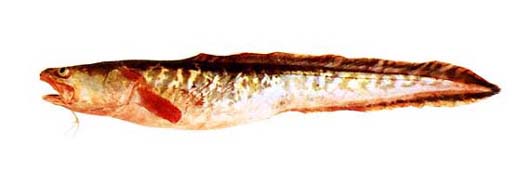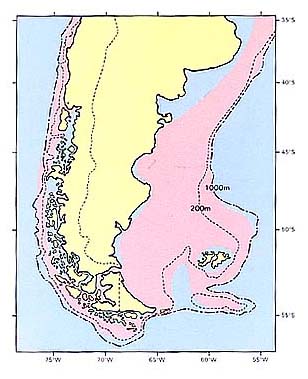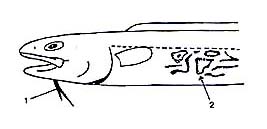アシロ科
- HOME
- デジタル図鑑
- パタゴニア海域の重要水族
- 硬骨魚綱 アシロ目
- アシロ科
アシロ科(Ophidiidae)

44 リング(Ringu)
Genypterus blacodes (Schneider, 1801)
Abadejo, Bacalao del sur, Dorado (Arg.); Ymakara, Himakhara (Tierra del Fuego); Abadejo, Congrio dorado (Ch.); Bacalao del sur (Urg.); Congrio colorado (Peru); Ling, Hokarai (NZ.); Ling (Aus.)
キング,キングクリップ,リング(業界名)
特 徴:
背鰭115~155軟条,臀鰭90~117軟条,胸鰭19~24軟条,腹鰭2軟条,鰓耙数2~4+4~5+3~6=10~13,鰓条骨数7,脊椎骨数19~20+47~49=67~69。体形はほぼ同筒形で,尾部はやや側扁し,体長は体高の7.0~7.7倍。頭は大きく,やや縦扁し,体長は頭長の4.1~4.6倍。眼は小さくて,頭長は眼径の8.2~8.7倍。吻は短く円鈍。主鰓蓋骨には皮下にかくれた大きな1棘がある。口は大きく上顎後縁は眼の後縁下をはるかに越える。上顎は前方に突出し下顎にかぶさる。両顎,鋤骨,口蓋骨に鋭い円錐歯がまばらに並び,とくに上顎縫合部に大きな犬歯がある。胸鰭はやや小さくその先端は丸い。背鰭は胸鰭基底よりやや後方から始まり,その基底は長い。臀鰭は体の中央よりやや前方に始まり,その基底は長いが背鰭の基底より短い。背鰭と臀鰭は尾鰭に連続する。腹鰭は喉位で眼の下に位置し,2本の糸状物からなる。鱗は薄い小円鱗で皮下に埋没する。側線は体側中央より背部よりをほぼ真直ぐに鰓蓋上縁上部から尾鰭前方まで走る。背部から体側部にかけて赤桃色地に,赤褐色の斑紋が不規則に散在する。腹部は白桃色。腹鰭は白い。体色と斑紋には個体変異が著しい。体長は1mを越えるが,80cmまでが普通。
分 布:
ブラジル南部からペルー南部にかけての南アメリカ大陸南部,ニュージーランド,オーストラリア大陸南部の陸棚上。
備 考:
南アフリカに本種に酷似するKingklip, G. capensis(Smith, 1849)が分布し,やはり水産上の重要種。1977年から1982年までの本種のアルゼンチンにおける漁獲量は2,948t,5,050t,7,343t,6,561t,4,346t,8,820t(FAO, 1984)。肉質は白身で極めて良好,アルゼンチンでもチリでもフライとして賞味され最高級魚とされる。(中村 泉)
Material examined:
10 from Argentina (318.3 mm SL), 10 from Chile (355.9-628.2 mm SL). FAKU 42779, 40803, 42850, 42984, 42985; AP 817-821; CP 79, 130, 273, 549, 550, 773, 936, 938, 941, 942.
Description:
D 115-155; A 90-117; P1 19-24; P2 2; GR 2-4+4-5+3-6=10-13; BS 7; Ⅴ 19-20+47-49=67-69. HL 21.7-24.7 % of SL; BD 11.9-14.3; ED 2.5-3.4; FO 2.5-3.4; SN 4.1-6.5; IO 2.6-5.2; UJ 8.9-10.6; P1L 8.2-11.0; P2 6.8-9.7; DH 4.1-5.3; AH 4.1-5.1.
Body extremely elongate and compressed posteriorly, body depth 7.0-7.7 times in SL. Head depressed and rather large, 4.1-4.6 times in SL. Snout blunt, slightly longer than fleshy orbit diameter. Eye small, 8.2-8.7 times in head. Fleshy orbit 5-7 times in head. Mouth evenly curved and large, reaching to posterior margin of eye. Upper jaw slightly anterior to lower jaw. Strong uniserial conical teeth distally placed on both jaws, anterior teeth longer than posterior ones on lower jaw. Villiform inner tooth bands on both jaws. Several strong conical teeth sparcely set on vomer and uniserial on palatines. Interorbital region flat and wide, its width nearly as wide as fleshy orbit diameter. Gill-rakers short with minute serrations. Pseudobranchiae present. A strong opercular spine half embedded in skin. Nostrils well separated from each other; anterior nostril small, round, without a flap. Pectoral fin round and rather short, 2.1-2.3 times in head. Pelvic fin jugular with 2 elongate thread-like rays, larger ray about as long as lower jaw length. Dorsal fin originating above middle of pectoral fin. Anal fin originating slightly anterior to midbody. Fine cycloid scales on body and posterior part of head. Lateral line parallel and closer to dorsal profile. Body pinkish yellow, marbled with irregular reddish brown blotches dorsally.
Distribution:
Both Chilean and Argentine Patagonia, also known from New Zealand (Whitley, 1968) and Australia (Scott, Glover and Southcott, 1974; Last, Scott and Talbot, 1983).
Remarks:
Nomenclature on Genypterus is tangled, and the literature is apparently filled with misidentifications (Cohen and Nielsen, 1978).
(Izumi NAKAMURA)

Distribution of Genypterus blacodes in Patagonia.

Anterior part of body. Pelvic fin (1) and body mark (2).